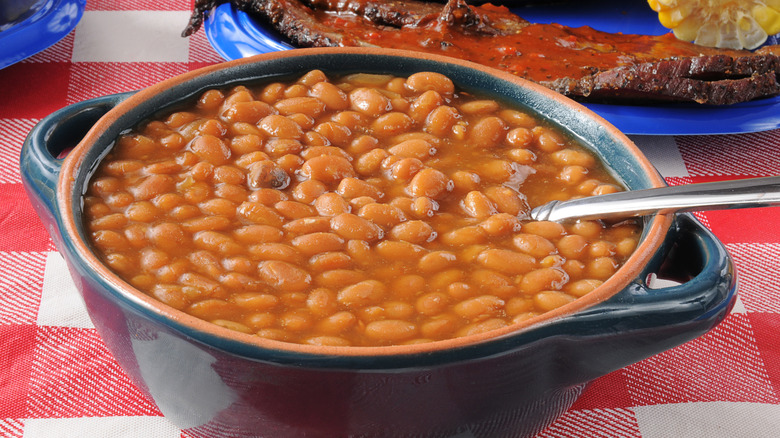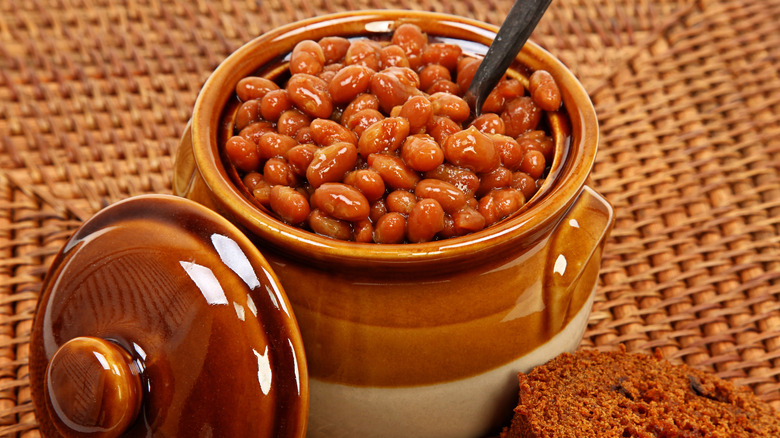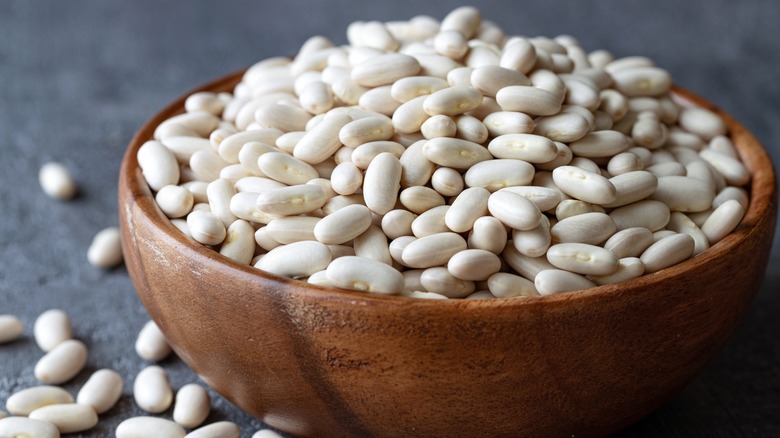The Subtle Difference Between Maine And Boston Baked Beans
The typical Bostonian would never let the moniker of "Beantown" slip through their lips, but the city undoubtedly deserves its nickname. Boston baked beans are so central to the city's cuisine that, according to the Society for American Baseball Research, its baseball team was once known as the Boston Beaneaters (imagine slipping that into "Take Me Out to the Ball Game"). The sweet and savory dish, flavored with ingredients like molasses and salt pork, is now ubiquitous throughout the nation, but few outside of New England will recognize their rival: Maine baked beans.
Bostonians and Mainers alike will fiercely defend their respective baked bean varieties. The dual dishes have become a point of contention within New England, and not one to be taken lightly. One Lewiston Maine newspaper was quoted criticizing the Massachusetts version as "a sort of brown paste with small nubbly particles in it, dejected in appearance," (via Serious Eats). Those are harsh words, but they only go to show how important baked beans are in New England, not only as a staple food but also as a cultural symbol. In fact, they played a significant role in the region's history, dating back well before the arrival of European colonizers.
Baked beans are a Native American invention
Beans, corn, and squash were three staple foods for many Native American peoples throughout the Americas. As Navajo journalist Andi Murphy notes in an article for PBS, beans, corn, and squash are known as the Three Sisters in indigenous cooking. They rose to prominence for their nutritional value and their unique symbiotic relationship. Beans planted at the base of corn and squash fertilize the soil while the corn stalk supports the bean vines and squash leaves protect the beans.
As the Maine Folklife Center explains, colonists were introduced to beans by the Algonquin-speaking tribes of New England, who baked beans in ceramic pots with maple syrup and bear fat. The sweet and savory contrast they achieved defines the dish even to this day. It was a perfect fit for the Pilgrims' Puritan lifestyle, which forbid cooking on Sunday, the sabbath. Baking beans is a slow process, so they could be put in the oven on Saturday night and come out hot and ready on Sunday morning.
One of the most important developments in the history of New England baked beans came by way of America's darkest period, during the height of the Atlantic slave trade. The so-called "Triangular Trade" between Europe, Africa, and the Americas brought molasses to New England (via PBS). Molasses replaced maple syrup as the preferred sweetener of baked beans, which also thickened the dish's texture. So molasses is one thing that Maine and Boston baked beans have in common, but what is the difference?
Maine and Massachusetts use different beans
According to the Maine Folklife Center, Boston baked beans are traditionally made with white navy beans or pea beans, small varieties that have thin skins. When cooked, they easily break down into a paste, which gives Boston baked beans a thicker texture than their Maine counterpart. That's because Maine baked beans use bean varieties that are native to the state, including Marifax beans and soldier beans. However, the most popular variety of Maine beans is the yellow-eye bean, which earns its name from the golden spot that each bean bears. These beans give the dish a distinct earthy flavor that most distinguishes Maine baked beans from Boston baked means.
Traditionally, Maine baked beans are cooked in a ceramic or brick oven. The Main Folklike Center explains that this method has been preserved by B&M, one of the most popular brands of canned baked beans, and the standard example of baked beans in the eyes of many Mainers.


